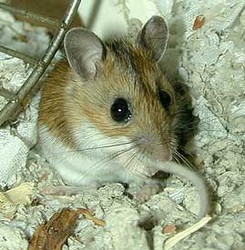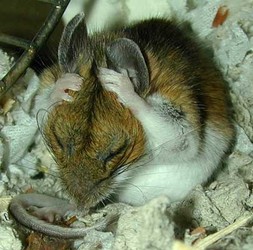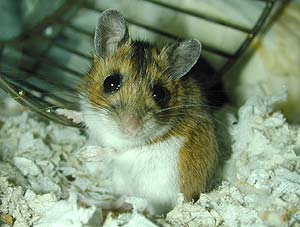Taxonomy:
The house mouse belongs to the Kingdom: Animalia, Phylum: Chordata, Class: Mammalia, Order: Rodentia, Family: Muridae, Subfamily: Murinae, Genus: Mus, Species: musculus [5]. Its Binomial name is Mus musculus.
There have been a number of sub species of Mus musculus that have been described. These include: Mus musculus bactrianus (southwestern Asian house mouse), Mus musculus castaneus (southeastern Asian house mouse), Mus musculus domesticus or Mus musculus domesticus (western European house mouse), Mus musculus gentilulus, Mus musculus homourus, Mus musculus molossinus, Mus musculus musculus (eastern European house mouse), Mus musculus praetextus, and Mus musculus wagneri [5].
Development
The house mouse begins life through sexual reproduction between a male and a female. The female contributes an egg cell, and the male contributes a sperm cell, both of which are called gametes. These fuse together to produce a single cell, called the zygote, or fertilized egg.
Over the course of 18-21 days, the zygote grows into an embryo and then a fetus in the female’s uterus. The mother gives birth to approximately three to twelve offspring, on average five or six, and in suitable conditions have five to ten litters per year [1].
The house mouse’s is a triploblastic organism [2]. It has three tissue layers, an ectoderm which forms nervous tissue and other organs, a mesoderm which forms the reproductive structures and other parts, and an endoderm which builds the gut and other internal organs. The developing house mouse has a coelom, which is a body cavity that develops within the mesoderm. It also has bilateral symmetry, meaning the left and right sides of the body are mirror images of each other. It develops a nervous system, internal organs, eyes, brain, and more.
After birth, at 10 days of age they have all of their fur, at 14 days they open their eyes, and at 3 weeks they are weaned from their mother [1]. Young house mice stay with their mother until they are about 21 days old [1]. As early as five weeks of age, male and females can breed, although the male usually matures at 8 weeks, and the females at 6 weeks. Wild house mice live approximately 12 to 18 months, and captive house mice have an average life span of 2 years. Breeding of captive house mice occurs any time during the year, for wild house mice, breeding during the colder months of the year seems to be restricted. [4].
Major Characteristics and Habitat:
The house mouse is a rather small, lightly furred mammal. Its ears are bare and big. Their fur comes in many colors, from white to black, and some even have spots [1]. The belly of the house mouse is usually white or very light brown [4]. And some people think they are cute!


Mus musculus. © January 2000 Chuck Pound
Adults weight in at about 12 to 40 grams and are 15 to 19 centimeters long [5]. The house mouse has four legs, two oversized ears, whiskers, and a scaly tail [4]. The house mouse is an omnivore [1], but primarily eats plant material, including seeds, green stems, and leaves [4]. It will also often store food that it finds, or live within a human storage facility [1]. They also drink water, but don’t require much of it as they get most of their moisture requirements from the moisture that is present in the food that they eat [5].
The house mouse is primarily a nocturnal animal. Because of this they have very little or absolutely no color vision [5]. Their hearing is very sharp, and they can perceive ultrasounds [5]. They communicate to each other via squeaks in both the human range of hearing for long distance warnings and they also sqeak to each other in the ultra sound range for short distance communication [5].


Mus musculus. © January 2000 Chuck Pound
Another source of communication that house mice rely on is through the use of pheremones [5]. The preputial gland produces most of the pheremones for both males and females and is excreted in their urine [5]. In addition, the array of whiskers that the house mouse posses on each side of its nose allows it to sense air movement and surfaces, similar to a cat [5].
Originally the house mouse was native to Asia. They spread to Europe, and then humans introduced them throughout the world [5]. They usually live in close proximity to humans, in or around houses or fields [1]. They also live in captivity, in cages in home or laboratories for example. Because of they live close to humans, house mice can be found inhabiting areas that would normally be considered inhospitable to them, such as the tundra or deserts [1]. They usually keep hidden as a means of protecting themselves, and are quick runners at up to eight miles per hour [1].
It is usually the prey of other animals in its environment – including but not limited cats, foxes, weasels, ferrets, mongooses, large lizards, snakes, hawks, falcons, and owls. House mice try to avoid being eaten by keeping away from the open and by being fast [1]. Rats will also often kill and eat part of the house mouse [5]. This behavior is known as muricide.
Sometimes the house mouse is the predator itself. In Gough Island, they have become unusually large and learned to attack in groups albatross chicks, which are mostly immobile, gnawing on the chicks until the are dead [5].


Mus musculus. © January 2000 Chuck Pound
The house mouse is often used by scientists as subjects for biological, genetic, and medical studies [4]. They are frequently used because their physiology is quite similar to a human’s, and because of their short breeding cycle, breeding is quick and easy [5]. Most of the laboratory mice are hybrid subspieces of the Mus musculus; the most commonly used in the laboratories are Mus musculus domesticus and Mus musculus musculus [5].
While being great research animals, the house mouse can also cause problems for humans. Because house mice often live very close to humans and in human homes, they often destroy furniture, walls, carpeting, and clothing. They are pests in agricultural areas. They can contribute to the spread of diseases such as murine typhus, rickettsial pox, tularemia, food poisoning (Salmonella), and bubonic plague [1]. It also carries a virus called the mouse mammary tumor virus, which may contribute to breast cancer in humans [1].
The House Mouse’s Tale:
In late 2002, the house mouse genome sequencing was completed. The genome of the house mouse is three billion bases long, which is equal to the size of the human genome [5]. An estimation of the number is genes is about 30,000 to 50,000, which is also equal to that of humans [5].
The genome is a sort of “tool box” for building the cells. Mouse bone cells and human bone cells are more similar to each other than mouse bone cells and mouse liver cells [6]. The behavior of these bone cells may be different between mice and humans, but as all mammals are about the same size, they need the same types of “toolboxes” to build from. Interestingly, when one compares the genes in mice to the genes in humans, many of them share high sequence similarity. Especially in the genes that regulate developmental processes, like the homeobox genes (hox genes). Thus, if scientists can understand how these genes work in the mice, they may also figure out a lot about how humans develop! Thus, the common house mouse is actually a very important player in understanding how mammals, including ourselves develop.
Challenge Question:
How many other organisms have the same, or approximately the same size genome and number of genes as humans?




 Go to quick links
Go to quick search
Go to navigation for this section of the ToL site
Go to detailed links for the ToL site
Go to quick links
Go to quick search
Go to navigation for this section of the ToL site
Go to detailed links for the ToL site